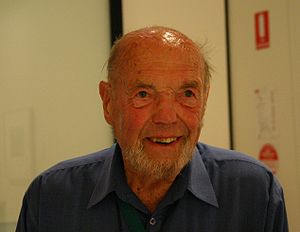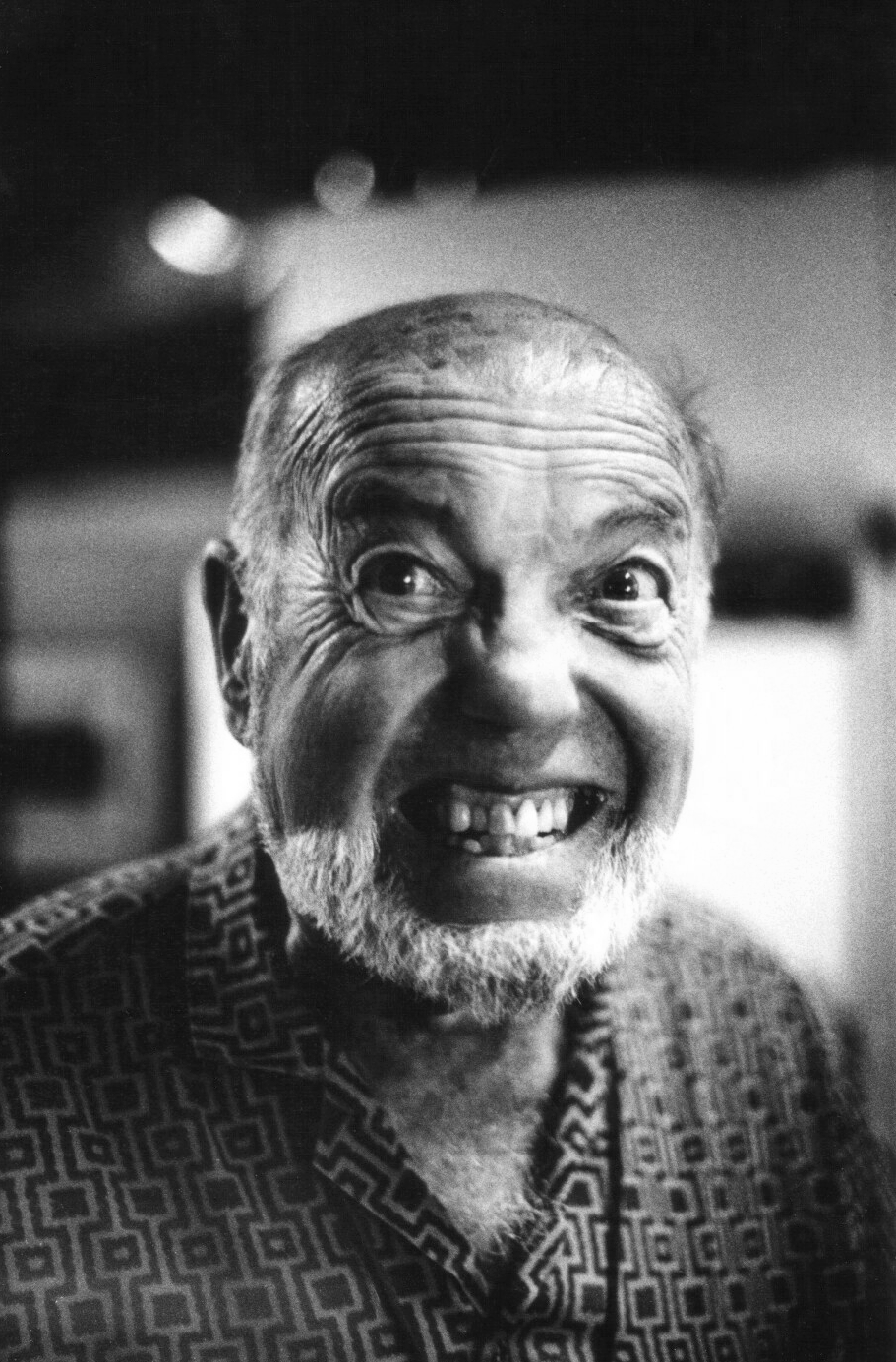
Wolfgang Sievers
Encyclopedia


Order of Australia
The Order of Australia is an order of chivalry established on 14 February 1975 by Elizabeth II, Queen of Australia, "for the purpose of according recognition to Australian citizens and other persons for achievement or for meritorious service"...
(18 September 1913 – 7 August 2007) was an Australia
Australia
Australia , officially the Commonwealth of Australia, is a country in the Southern Hemisphere comprising the mainland of the Australian continent, the island of Tasmania, and numerous smaller islands in the Indian and Pacific Oceans. It is the world's sixth-largest country by total area...
n photographer who specialised in architectural and industrial photography.
Seivers was born in Berlin
Berlin
Berlin is the capital city of Germany and is one of the 16 states of Germany. With a population of 3.45 million people, Berlin is Germany's largest city. It is the second most populous city proper and the seventh most populous urban area in the European Union...
, Germany
Germany
Germany , officially the Federal Republic of Germany , is a federal parliamentary republic in Europe. The country consists of 16 states while the capital and largest city is Berlin. Germany covers an area of 357,021 km2 and has a largely temperate seasonal climate...
. His father was Professor Johannes Sievers, an art and architectural historian with the German Foreign Office until his dismissal by the Nazi government in 1933, and author of the first four volumes of a monograph on neo-classical architect Karl Schinkel. His mother was Herma Schiffer, a writer and educator of Jewish background who was Director of the Institute for Educational Films.
From 1936 to 1938, he studied at the Contempora—Lehrateliers für neue Werkkunst in Berlin, a progressive private art school created by architect Fritz August Breuhaus
Fritz August Breuhaus
Fritz August Breuhaus, was born on february 9th, 1883 in Solingen, Germany. He was a famous German architect, interior designer, and designer in the 20th century. He added “de Groot” to the end of his name in 1929. He spread the word of this addition claiming to be the grandson/great-grandson of a...
de Groot, which like the famous Bauhaus
Bauhaus
', commonly known simply as Bauhaus, was a school in Germany that combined crafts and the fine arts, and was famous for the approach to design that it publicized and taught. It operated from 1919 to 1933. At that time the German term stood for "School of Building".The Bauhaus school was founded by...
, strongly emphasized the unity of all applied arts. He took architectural photographs for his father's books on Berlin's historical buildings, particularly the work of Karl Schinkel. He also spent a year working in Portugal
Portugal
Portugal , officially the Portuguese Republic is a country situated in southwestern Europe on the Iberian Peninsula. Portugal is the westernmost country of Europe, and is bordered by the Atlantic Ocean to the West and South and by Spain to the North and East. The Atlantic archipelagos of the...
1935 to 1936. In 1938, he was retained as a teacher at the Contempora, but decided to emigrate to Australia following rumours of the school's imminent closure by the authorities. He had arranged for his photographic equipment to be transported, but was briefly questioned by the Gestapo
Gestapo
The Gestapo was the official secret police of Nazi Germany. Beginning on 20 April 1934, it was under the administration of the SS leader Heinrich Himmler in his position as Chief of German Police...
, then conscripted as an aerial photographer for the Luftwaffe
Luftwaffe
Luftwaffe is a generic German term for an air force. It is also the official name for two of the four historic German air forces, the Wehrmacht air arm founded in 1935 and disbanded in 1946; and the current Bundeswehr air arm founded in 1956....
. He fled the country immediately, going first to England
England
England is a country that is part of the United Kingdom. It shares land borders with Scotland to the north and Wales to the west; the Irish Sea is to the north west, the Celtic Sea to the south west, with the North Sea to the east and the English Channel to the south separating it from continental...
in June.
In Australia, Sievers opened a studio in South Yarra, Melbourne
Melbourne
Melbourne is the capital and most populous city in the state of Victoria, and the second most populous city in Australia. The Melbourne City Centre is the hub of the greater metropolitan area and the Census statistical division—of which "Melbourne" is the common name. As of June 2009, the greater...
. After war was declared, he volunteered for the Australian Army and served from 1942 to 1946. Following demobilisation, he established a studio at Grosvenor Chambers
Grosvenor Chambers
Grosvenor Chambers at number 9 Collins Street, Melbourne was Australia's first custom built complex of artist's studios.It housed many famous Australian artists studios. Some artists who held studios there include, Tom Roberts, Arthur Streeton, Clara Southern, Charles Conder, E...
in fashionable Collins Street, initially drawing many of his commissions from fellow European immigrants including the architect Frederick Romberg, and Ernst Fuchs who had arrived from Vienna
Vienna
Vienna is the capital and largest city of the Republic of Austria and one of the nine states of Austria. Vienna is Austria's primary city, with a population of about 1.723 million , and is by far the largest city in Austria, as well as its cultural, economic, and political centre...
. During his early years in Melbourne, Sievers became a lifelong friend of fellow émigré photographer Helmut Newton
Helmut Newton
Helmut Newton, born Helmut Neustädter was a German-Australian photographer. He was a "prolific, widely imitated fashion photographer whose provocative, erotically charged black-and-white photos were a mainstay of Vogue and other publications."-Early life:Newton was born in Berlin, the son of Klara...
and his Australian actress wife June Browne
June Browne
June Browne Newton born in Melbourne, Australia, in 1923 is an Australian actress who later became a successful photographer under the ironic pseudonym 'Alice Springs' ....
, who later made photographs herself under the pseudonym "Alice Springs".
Work
Significant corporate clients included AlcoaAlcoa
Alcoa Inc. is the world's third largest producer of aluminum, behind Rio Tinto Alcan and Rusal. From its operational headquarters in Pittsburgh, Pennsylvania, Alcoa conducts operations in 31 countries...
, Australian Paper Manufacturers, Comalco
Comalco
Rio Tinto Aluminium is now known as Rio Tinto Alcan after Rio's takeover of Alcan. It was the world's eighth largest aluminium company...
, Hamersley Iron
Hamersley Iron
Pilbara Iron is a wholly owned subsidiary of the multinational Rio Tinto Group, that manages assets for Hamersley Iron Pty Ltd, a wholly owned subsidiary of Rio Tinto, and Robe River Iron Associates, an unincorporated joint venture between Rio and three Japanese steel companies Mitsui Iron Ore...
, John Holland Group, John Lysaght, Shell
Royal Dutch Shell
Royal Dutch Shell plc , commonly known as Shell, is a global oil and gas company headquartered in The Hague, Netherlands and with its registered office in London, United Kingdom. It is the fifth-largest company in the world according to a composite measure by Forbes magazine and one of the six...
and Vickers Ruwolt. He also received commissions from architectural firms including Bates, Smart and McCutcheon, Hassall & McConnell, Leith & Bartlett, Winston Hall and Yuncken Freeman
Yuncken Freeman
Yuncken Freeman is an Australian architecture firm. Yuncken Freeman has grown steadily over the years particularly from the economic boom from the 1950s to 1980s to be a sizeable firm in Australia...
. In the 1950s, Sievers was engaged by the then Department of Overseas Trade
Department of Foreign Affairs and Trade (Australia)
The Department of Foreign Affairs and Trade is a department of the government of Australia charged with advancing the interests of Australia and its citizens internationally...
with a brief to change Australia's image from a land of sheep and wool to an image of a sophisticated industrial and manufacturing nation. Many of these images were published in Walkabout magazine
Walkabout magazine
Walkabout was an Australian illustrated magazine published from 1934 to 1974 combining cultural, geographic, and scientific content with travel literature. Initially a travel magazine, in its forty-year run it featured a popular mix of articles by travellers, officials, residents, journalists, and...
.
Sievers' work after the war was imbued with the Bauhaus
Bauhaus
', commonly known simply as Bauhaus, was a school in Germany that combined crafts and the fine arts, and was famous for the approach to design that it publicized and taught. It operated from 1919 to 1933. At that time the German term stood for "School of Building".The Bauhaus school was founded by...
ethos and philosophy of the New Objectivity
New Objectivity
The New Objectivity is a term used to characterize the attitude of public life in Weimar Germany as well as the art, literature, music, and architecture created to adapt to it...
he had learned in Berlin, combined with a socialist belief in the inherent dignity of labour. His photographs were often overtly theatrical, as he commonly photographed industrial machinery at night, isolating details with artificial light and posing workers for heightened effect. This can be seen in 'Gears for Mining Industry' (1967), perhaps his most well known single image. This approach was extraordinarily influential in Australian post-war commercial photography.
In 1989, the Australian National Gallery staged a retrospective of his work, an exhibition which travelled around the country, often accompanied by Sievers' lectures. In 2000, he was the subject of a major retrospective exhibition held in Lisbon
Lisbon
Lisbon is the capital city and largest city of Portugal with a population of 545,245 within its administrative limits on a land area of . The urban area of Lisbon extends beyond the administrative city limits with a population of 3 million on an area of , making it the 9th most populous urban...
, Portugal
Portugal
Portugal , officially the Portuguese Republic is a country situated in southwestern Europe on the Iberian Peninsula. Portugal is the westernmost country of Europe, and is bordered by the Atlantic Ocean to the West and South and by Spain to the North and East. The Atlantic archipelagos of the...
at the "Arquivo Fotografico Municipal de Lisboa". For his services to photography, he was appointed an Officer of the Order of Australia (AO) in 2002.
The National Library of Australia
National Library of Australia
The National Library of Australia is the largest reference library of Australia, responsible under the terms of the National Library Act for "maintaining and developing a national collection of library material, including a comprehensive collection of library material relating to Australia and the...
has an archive of more than 50,000 of Sievers' negatives and transparencies.
Sievers was active in Australia, Germany and Austria with research into the emigration of war criminals to Australia from 1990 to 1998. In 2007, he donated several hundred photographs from his archive, worth up to A$1 million, to raise money for justice and civil liberties causes.
Wolfgang Sievers died at the age of 93, a month short of his 94th birthday.
Further reading
- Helen Ennis, 'Blue hydrangeas: Four émigré photographers' in The Europeans: Émigré Artists in Australia 1930-1960, Roger Butler (ed.), National Gallery of Australia, 1997.
- The Life and Work of Wolfgang Sievers, Australian National Gallery exhibition catalogue, 1989.
External links
- Foreign Influences in Australian Photography 1930-80 by Robert Deane
- http://nla.gov.au/nla.pic-an24410125Photographic archive 1938-1991 held at the National Library of Australia in CanberraCanberraCanberra is the capital city of Australia. With a population of over 345,000, it is Australia's largest inland city and the eighth-largest city overall. The city is located at the northern end of the Australian Capital Territory , south-west of Sydney, and north-east of Melbourne...
] - Celebrated photographer Sievers dies
- Melbourne post-war photography State Library of Victoria, Australia

